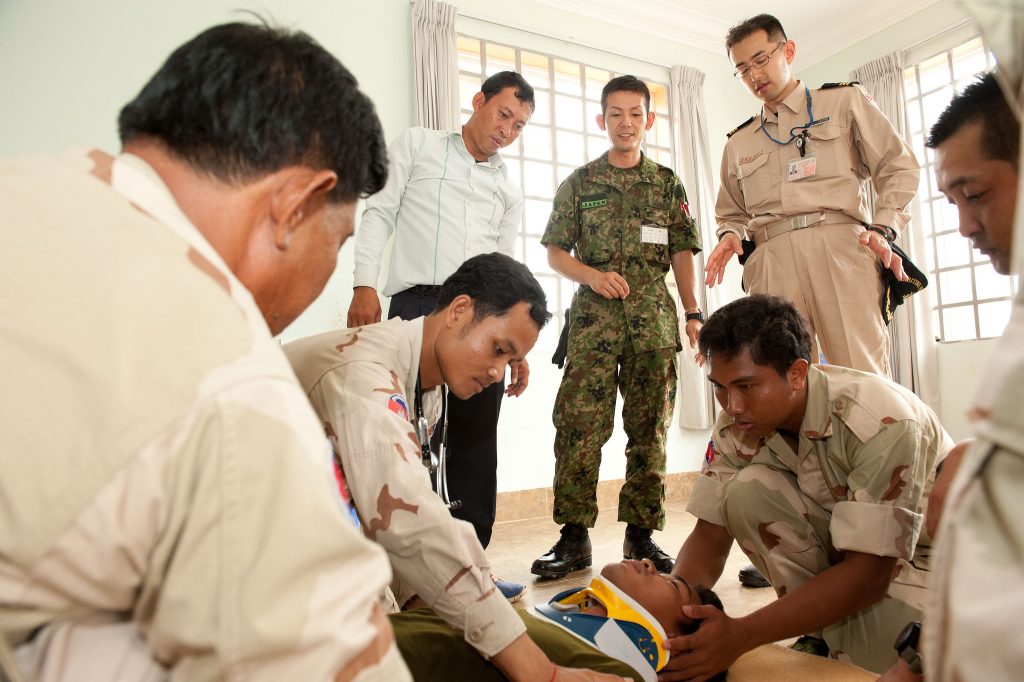
Japanese military members observe as Cambodian sailors attach a neck brace to a patient during a Pacific Partnership knowledge exchange in Sihanoukville, Cambodia. Photo by U.S. Pacific Fleet, taken on 21 June 2014. Licensed under CC BY-NC 2.0
Japan, through its official development branch called Japan International Cooperation Agency (JICA), has been the largest bilateral donor to Cambodia for years (excluding China, since their aid does not always come in traditional methods). Between 1992 and 2018, Japan provided the equivalent of over US$2.8 billion in Official Development Assistance.1 This accounted for around 15 percent of financing from all development partners.
Japan’s assistance has included support for the construction, expansion or renewal of key infrastructure, including:
- bridges such as the Kizuna Bridge and the Tsubasa Bridge (the latter is the longest bridge over the Mekong River in Cambodia, and opened to traffic in 2015)
- improving National Roads No. 1 and 5 and other highways
- developing a new container terminal at Sihanoukville Autonomous Port to double its capacity and allow larger vessels to call
- extensive improvements to flood protection and drainage in Phnom Penh.
Regulation and development framework
Japan’s basic development philosophy is “invest in the future.”2 Thus, it is Japan’s primary goals to strengthen Cambodia’s economy through sustainable and strategic growth. In order to achieve these goals, JICA has consistently funded projects in infrastructure and communication sectors. Many of Japan’s on-going projects are set up to include grant aid mixed with technical assistance.
For example, parts of the urban development projects include revamping the public bus system,3 and upgrading Phnom Penh’s drainage system to reduce city flooding.4 The projects are designed to include Japanese assistance, but are being implemented as capacity building and training projects that will provide jobs and make working in Phnom Penh easier.5
The sectors of greatest support have been selected because the deliverable results are congruent with Japan’s sustainable growth model. Japan is most focused on economic growth, and thus is attempting to assist Cambodia maintain a 7 percent per year growth rate with a manageable inflation rate and stable interactions with the international market.6 Thus far, Cambodia’s economy has responded well to JICA’s projects – the economy, according to Prime Minister Hun Sen on 28 June 2016, has grown by 7.1 percent and the inflation rate stayed below 1.9 percent.7
Another reason JICA has favored infrastructure and communication is because Japan is one of the largest stakeholders in ASEAN, and has been working to support ASEAN’s developing countries enter the global and regional economy.8
Finally, to achieve these development goals, Japan has also funded private sector growth and bolstered rural development. Japan’s secondary and tertiary development goals are the promotion of social development, and strengthening Cambodian governance.9
In March 2016, JICA donated US$215.5 million in grants and loans for “The Project for Rehabilitation of the Chroy Changwar Bridge”, “The Project for Improvement of Equipment for Demining Activities (Phase VII)”, and “National Road No.5 Improvement Project (Prek Kdam – Thlea Ma’am Section) II”.10 In June 2016, an agreement was signed for implementation of the Project for Improvement of Marine Aquaculture Seed Production Techniques. The project focuses on capacity development at the Marine Aquaculture Development Center in Sihanoukville province, a facility constructed with Japanese aid in 2012.
Other existing projects underway
- The Project for Educational Resource Development in Science and Mathematics at the Lower Secondary Level (STEP SAM3)
- The Project for Improving Maternal and Newborn Care through Midwifery Capacity Development
- The 50th Anniversary of JOCV
- The Project for Flood Protection and Drainage Improvement in the Phnom Penh Capital City
- Agricultural Productivity Promotion Project in West Tonle Sap
- 7 ECO City Project
Last update: 31 May 2019
Related to Japanese aid
References
- 1. Ministry of Information, 29 May 2019. PM Hun Sen thanks japan for support for Cambodia’s growth. https://www.information.gov.kh/detail/302491 Accessed 30 May 2019.
- 2. Japan’s International Cooperation. “Japan’s Official Development Assistance White Papers 2104.” p. 215. http://www.mofa.go.jp/files/000118826.pdf
- 3. Japan’s International Cooperation. “Japan’s Official Development Assistance White Papers 2104.” p. 63. http://www.mofa.go.jp/files/000118826.pdf
- 4. Bun Sengkong and Igor Kossov, “Capital’s ‘top hazard’: flooding”, The Phnom Penh Post, 2 May 2016. http://www.phnompenhpost.com/national/capitals-top-hazard-flooding
- 5. Ibid.
- 6. Council for the Development of Cambodia (CDC). Donor development cooperation programs. “Development priorities of Royal Government of Cambodia.” http://www.cdc-crdb.gov.kh/cdc/Donor_Development_Cooperation_Programs/Japan/12th_policy_dialogue_on_oda/downloads/2_1_RGC_Development_Priorities_revised.pdf
- 7. Post staff. “Hun Sen sees the signs of a strong economy.” The Phnom Penh Post, 28 June 2016. http://www.phnompenhpost.com/business/hun-sen-sees-signs-strong-economy
- 8. Japan’s International Cooperation. “Japan’s Official Development Assistance White Papers 2104” p. 217. http://www.mofa.go.jp/files/000118826.pdf
- 9. Embassy of Japan in Cambodia. Assistance for Cambodia. “ODA by project: Country assistance policy for Cambodia.” http://www.kh.emb-japan.go.jp/economic/cooperation/Assistance%20Policy.pdf
- 10. Japan International Cooperation Agency (JICA). “Press release: Signing grant and loan agreements between JICA Cambodia office and the Ministry of Economy and Finance.” 31 March 2016. http://www.jica.go.jp/cambodia/english/office/topics/press160331.html

